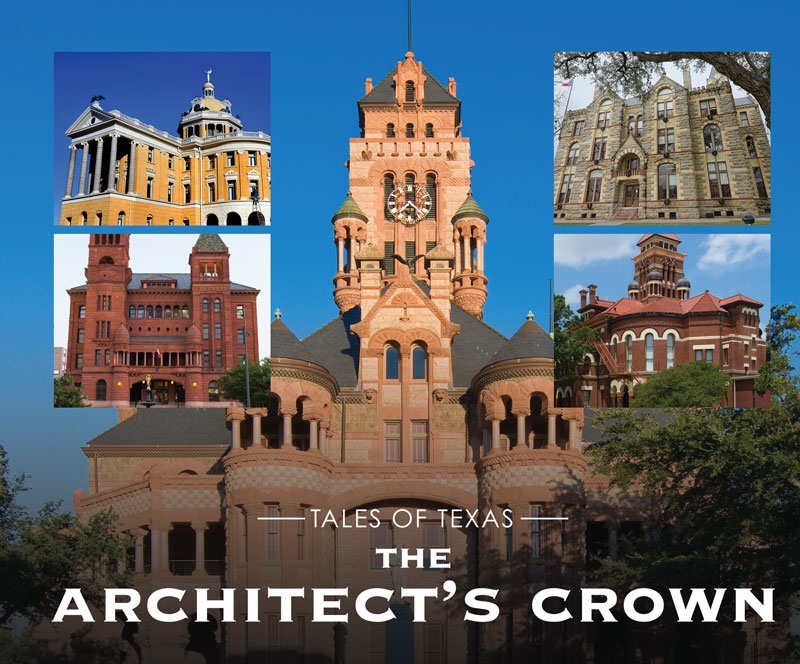
The well-known Ellis County Courthouse, while unique in many respects, also has similarities with other Texas courthouses. Several Texas county seats can boast of their offices being housed in buildings designed by the nationally recognized architect, James Riely Gordon. Gordon designed as many as 18 Texas courthouses — 12 of them are still standing — plus a number of other government and commercial buildings and private residences throughout the state. However, when researching information on him, the first picture that appears in most articles is of the Ellis County Courthouse, often said to be his crowning achievement.
In the book, Texas, by James Michener, Gordon’s Ellis County icon is referred to as “a fairy-tale palace 10 stories high, replete with battlements and turrets and spires and soaring clock towers and miniature castles high in the air. It was a bejeweled treasure, yet it was also a sturdy, massive court of judgments, one of the finest buildings in Texas.” As much acclaim as Gordon has for the edifice, he was never employed as architect by the county. Instead, his plans were sold to the county, and county officials hired Fort
Worth architect Marshal Sanguinet as consultant and construction supervisor. Gordon may have learned at least part of his craft from his civil engineer father, and after moving from his 1863 birthplace in Virginia to San Antonio, Texas, in the early 1870s, he joined the civil engineer corps of the International-Great Northern Railroad at age 14. Gordon never pursued a university degree in architecture, instead he began his career as a draftsman in 1881 for architect William K. Dobson in
San Antonio and later J.N. Preston & Son. In 1884, he opened his own San Antonio office with established architect Frederick Shelton. Being in the right place at the right time has probably influenced a number of great careers, and none is likely to surpass that of Gordon. In 1881, the Texas Legislature passed a bill allowing counties to borrow funds to build public buildings. Primitive courthouses around the state were often constructed of wood (even log structures) and subject to fire and storm damage. The bill passed in 1881 allowed counties to build larger buildings of much more substantial construction. Many of the buildings were enormous and attractive, contributing to the development of the courthouse squares and growth of the county seats.
From 1889 to 1902, Gordon designed 18 courthouses across The Lone Star State. This was considered the golden age of Texas courthouses, and a nice road trip around the state could include a visit to these magnificent buildings. Besides Ellis County, your trip could include Bexar, Comal, Erath, Fayette, Gonzales, Harrison, Hopkins, Lee, McLennan, Victoria and Wise. Some of the buildings that are still standing have been repurposed. Others have been restored and still serve as the seat of their county government.
The Ellis County Courthouse is of Richardsonian Romanesque style, as was the 1894 Brazoria County Courthouse, which no longer stands. Other courthouses designed by Gordon were Romanesque Revival, Beaux-Arts or a blend of styles. A beautiful home that Gordon designed in 1892 still stands in San Antonio. The George Kalteyer House is of Romanesque Revival style. According to sahouseregistry.com, “It is one of the most architecturally significant structures on this noted street. Gordon was best known as a super courthouse designer, but he was an excellent residential designer as well. This house, with its abundance of polychromed arches, reflects the architect’s mastery of the Romanesque Revival of the 1880s. The fine interior finishes have been fully restored. The majority of Gordon’s domestic work has unfortunately been long since demolished, making this specimen all the more important.”
In 1886, Gordon’s first major job was supervising the construction of the Federal Courthouse and Post Office in San Antonio, Texas. In 1892, he won a medal of merit for his design of the Texas Building at the Worlds Columbian Exposition in Chicago. His most important work outside of Texas was probably the Arizona Capitol in 1898.
The Texas State Historical Association indicates, “Gordon maintained several offices in Texas, one in Shreveport, Louisiana, and another in Phoenix, Arizona.” However, in 1902, he moved to New York. His reputation as a great architect was well established, and he served as president of the New York Society of Architects. His career spanned nearly 60 years, with much of his most noted work still standing in Texas. Ironically, no mention of Texas was recorded in his obituary in The New York Times in 1937.
Sources:
1. www.sites.Rootsweb.com.
2. www.texoso66.com.
3. www.texascooppower.com.
4. www.sahouseregistry.com.
5. https://alchetron.com.
Written by Bill Smith

You must be logged in to post a comment.